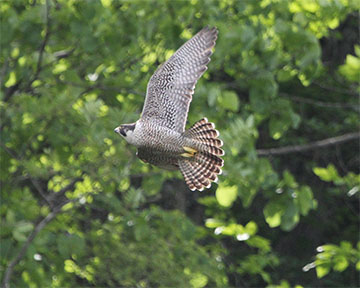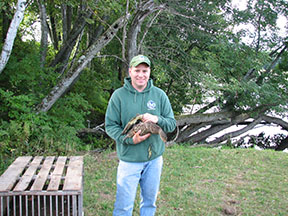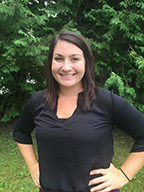
Peregrine Falcon Programs Bringing Back Adirondack Populations
By: Mary Godnick - Adirondack Council's Marketing and Development Assistant
January 10, 2017
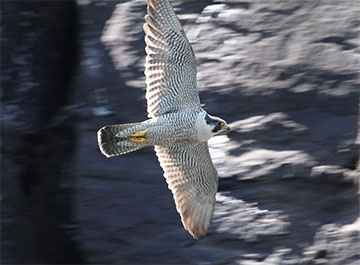
Photo courtesy of Connor Paschke,
NYSDEC Fish & Wildlife TechnicianAfter disappearing from New York State in the 1960's, peregrine falcon populations in the Adirondacks are back on the rise. This is not by chance. The New York State Department of Environmental Conservation (DEC) and volunteers across the state have made this possible with detailed annual nest site monitoring and management.
This predator is special to the Champlain region, mostly found in the state along the Champlain Coast and New York City area. To learn more about the rise in local falcon populations, we talked with John O'Connor, wildlife biologist and coordinator of the peregrine falcon program for the Adirondack and Lake Champlain region.
He explained that about 50 years ago, the peregrine falcon disappeared from New York because of exposure to toxins. John said, "Historically there were about 50 peregrine falcon nest sites throughout New York State, but by the early 1960’s, peregrines had disappeared from New York due to reproductive problems caused by the use of DDT." In 1975 the DEC stepped in. John explained that their efforts kicked off when "157 young peregrines were released at 12 different hack sites around the state from 1975 to 1988. An additional 12 birds were released later in Rochester. In 1985, two pairs of peregrines nested in the Adirondacks on their own."Luckily, their release back into the wild worked, John said. "This lead to a shift from restoration and recovery work to that of monitoring, management, and research, which continues today.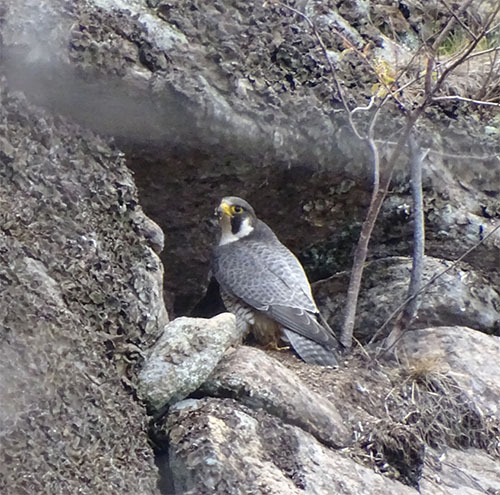
Peregrine Falcon Nest on Crane Mountain
Photo courtesy of Connor Paschke,
NYDEC Fish & Wildlife Technician
The peregrine falcon is still a fragile species in the area because of their breeding and nesting habits. There are only two places in the state that peregrines are found so the breeding population is small. He explains, "Peregrines are slow to reproduce. Most don’t breed until they are two or three years old and, on average, our Adirondack birds only successfully produce one or two young a year."
Human activity can also impact the populations from year to year. If people scare the parents away from the nest, John says that "eggs and young are vulnerable to chilling, overheating, and dehydration" and "persistent activity near nest sites can lead to abandonment." Human disturbances of nesting sites have been prevented by closing rock climbing areas to the public where known nests are located, giving the birds space to raise their young.
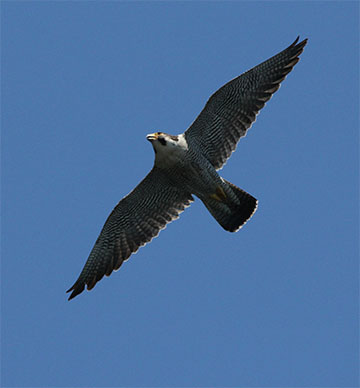 Photo courtesy of Connor Paschke, NYSDEC Fish & Wildlife TechnicianAdditionally, John says that the DEC heads "a large annual effort with staff and volunteers to locate all known peregrine nests in the state and record activity and productivity information." Potential nest sites are checked for any activity in the early breeding season. If a nest is found, they are then checked every few weeks "to determine how many eggs are laid (if possible), how many eggs hatch, and how many young successfully fledge." Up north, he says that most of the DEC's management involves temporarily closing specific rock climbing routes that fall into the territory of a breeding pair. This is communicated to the public with "posted signs, the DEC website, and emails to climbing groups." So be sure to check the DEC website before heading out for a climb, especially in the spring. Outside of the Adirondacks, he explains that the management is a little different. "Peregrines nest on bridges and on tall buildings in urban areas. The DEC places and maintains artificial nest boxes or platforms to encourage falcons to nest in appropriate places and increase nesting success. Bridge building, maintenance or construction is then coordinated to avoid or minimize disturbance to falcon nests. Some of these artificial nesting structures have webcams installed prior to breeding season." Data collection plays a big role in statewide research. John says, "Information is collected from all injured or dead peregrines found in New York. Egg shells and unhatched eggs are collected from nests and analyzed." This information is then stored in a database to track long-term trends. They also track birds movement with banding to track "dispersal, migration, survival, and longevity." While populations are on the rise, they aren't in the clear yet. John explains, "There is little argument that the peregrine population has recovered beyond historical levels in New York and across the country. Peregrines have been removed from the federal Endangered Species List and are now considered federally “recovered.” expect that peregrines will be downlisted from endangered to threatened here in New York within the next few years. While the population continues to grow in the state, with new nest sites located continuously, it is largely agreed that the birds need the extra levels of protection the State Endangered Species Act provides to maintain a self-sustaining population. A Peregrine Falcon Management Plan is currently being developed which should include achievable population goals for each of the ecological regions of the state."
So if you're not a scientist, what can you do to help? John says that the best thing you can do is to pay attention to rock climbing route closures and view falcons from a distance, never disturbing their nests. He encourages you to call the DEC Law Enforcement if you see an injured or dead falcon, or if you see someone climbing on a closed route, disturbing or harassing a falcon. They can be reached at 518-408-5850. If you'd like to get more involved, John says "People could also volunteer to monitor a nest site that is close to home or that they have a particular interest in. Volunteers are supplied with a manual and some training but must provide their own equipment." If you're interested in helping create a happy habitat for native birds at home, John says, "Most importantly is keep cats indoors. Second, keep bird feeders, and the area around feeders, clean to prevent disease and disease transmission. Placing and maintaining nest boxes and bird houses is helpful, but perhaps the easiest thing for a landowner to do is to conserve natural habitat." Sometimes, the best thing you can do, is nothing. He says, "You can do this by mowing less lawn, planting native trees and shrubs, or a wildflower garden. Even leaving dead trees standing, where safe to do so, is important for many species of birds." Let nature do its magic, and it will provide the needed resources and undisturbed habitat native birds need. To learn more about Peregrine Falcons in the Adirondacks, click HERE to visit the DEC's page. |
|
||||

